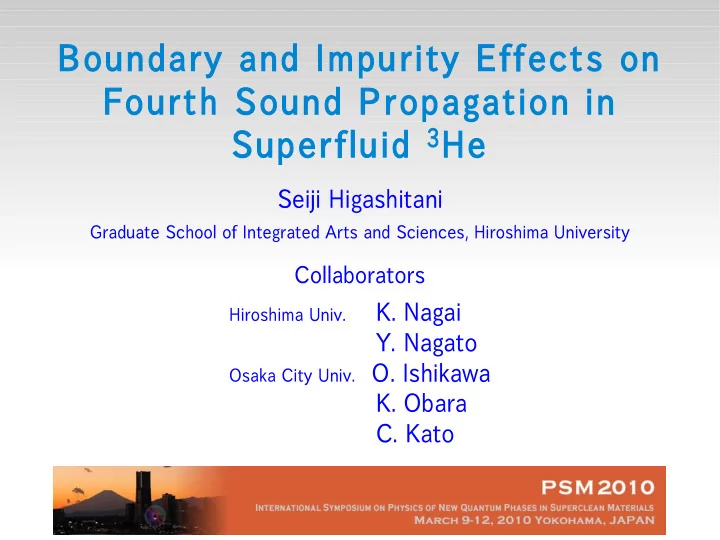

Boundary and Impurity Effects on Fourth Sound Propagation in Superfluid 3 He Seiji Higashitani Graduate School of Integrated Arts and Sciences, Hiroshima University Collaborators Hiroshima Univ. K. Nagai Y. Nagato Osaka City Univ. O. Ishikawa K. Obara C. Kato
Normal liquid 3 He between parallel plates Navier-Stokes equation Boundary conditions ( : slip length) Hagen-Poiseuille (HP) flow (ω = 0)
Normal liquid 3 He in aerogel Friction with aerogel Viscous penetration depth pure liquid 3 He Even in the low frequency limit, δ v takes a finite value.
Flow profile between a parallel plates D. Einzel and J. M. Parpia, PRL 81, 3896 (1998) 50 mK 10 mK 3 mK Cross sectional average of the mass current Effective flow relaxation time (flow conductance)
Fourth sound propagation in superfluid 3 He Two-fluid model Dispersion relation : cross sectional average ( 4 th sound velocity)
Dispersion relation (HP) (Drude) viscous penetration depth: fourth sound velocity:
Fourth sound resonance experiment resonator sintered silver powders L = 15 mm Aerogel (99 % porosity) is embedded in pores formed by sintered silver powders. The pore size is 〜 10 μm : energy loss
T c reduction 99 % aerogel 29 bar Normal Super
Superfluid density Temperature dependence of ρ s /ρ in superfluid 3 He-B
Energy loss of the fourth sound pure 3 He (2 nd mode) 4 th 5 th 3 rd 2 nd mode Q -1 is much reduced by the impurity effect. Q -1 aerogel decreases to zero in the low temperature limit, as in the case of Q -1 pure . Higashitani et al ., PRB 71, 134508 (2005)
Frictional relaxation time
Temperature dependence ofτ f in superfluid 3 He-B (τ imp = 20 ns) τ f ( T c ) = 60 ns τ f ( T c ) = 20, 15, 10 ns
The normal-fluid dynamics in aerogel The normal-fluid component is clamped by friction with aerogel. The normal-fluid velocity profile is almost constant across the pore. (Drude's law)
Summary We have analyzed the fourth sound resonance experiment on superfluid 3 He in 99 % porosity aerogel. The mean free path l = v F τ imp in the 99 % aerogel is ~ 700 nm. The normal-fluid dynamics underlying in the fourth sound propagation is governed not by the conventional HP law but by the Drude law. The energy loss formula for the Drude law is independent of the pore size d. The observation of the d- independence of the energy loss Q -1 gives another strong evidence of the Drude law.
Recommend
More recommend